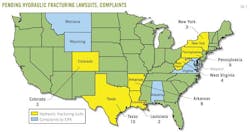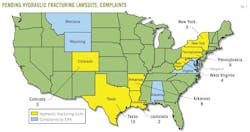Trends emerge on hydraulic fracturing litigation
Barclay Nicholson, Kadian Blanson
Fulbright & Jaworski LLP
Houston
A review of lawsuits involving fracturing and general themes and theories of current cases can reveal trends that are emerging from this body of litigation, and one can make some predictions about what is on the horizon.
These are important times for anyone in the natural gas industry because hydraulic fracturing will be required to access most of the sizable US recoverable gas reserves, estimated at about 1,176 tcf.1
Fracturing
Despite its history and effectiveness, fracturing has recently come under increasing scrutiny. Specifically, while the fluids used in fracturing consist predominantly of water, many allege that they also contain small amounts of toxic chemicals. Because fracturing uses large volumes of water, it also results in large volumes of flowback or produced water, which allegedly still contains trace amounts of chemicals.
Critics allege that flowback water can seep into nearby groundwater, polluting drinking water sources and affect long-term health.
The response to these alleged risks is still being calibrated, with courts, state and federal regulatory agencies, and energy companies. All are beginning to grapple with potential consequences on the environment.
Fracturing discharge already has been blamed for contaminating water in Arkansas, Colorado, Louisiana, New York, Pennsylvania, Texas, and West Virginia, resulting in several suits seeking damages for harm to physical property, as well as health.
In addition, many states either through their legislatures or their regulatory agencies have begun supervising the fracturing process more closely, and in some instances, curtailing it substantially.
Even more telling, Congress recently issued a directive to the US Environmental Protection Agency to assess whether fracturing poses a risk to drinking water.
In response, EPA prepared a draft study, which currently is undergoing review by EPA's science advisory board. The initial results of the study will be available in 2012.
Perhaps more important than looking at any issue separately is to glean what are the emerging general trends of this litigation and to make predictions about what is on the horizon.
Fig. 1 shows the hydraulic fracturing lawsuits and complaints by state.
Looking to the future
As it stands now, it seems unlikely that most states, especially those that are traditionally energy-resource friendly such as Texas or Oklahoma, will ban hydraulic fracturing outright or even regulate it to an extent that would discourage development.
That being said, the growing trend makes it likely that most areas with fracturing activity will adopt regulations requiring disclosure of chemicals used (as Texas recently did and as the governor of Colorado recently announced his state was considering) as a prerequisite for granting a permit.
In addition, states may adopt additional regulations for well operations that are more onerous than those placed on traditional oil and gas wells, as West Virginia has. These regulations require operators of wells that will be frac stimulated to submit a plan for how they intend to impound waste water to prevent contaminating nearby drinking water sources.
The results of the EPA study could have two prominent results. First, litigants likely will use the results as evidence of either the danger or lack thereof of the activity.
Displaying 1/6 Page 1, 2, 3, 4, 5,6Next>
View Article as Single page

